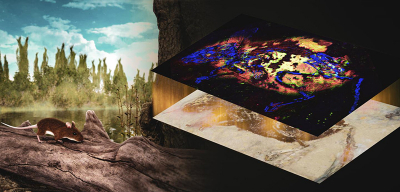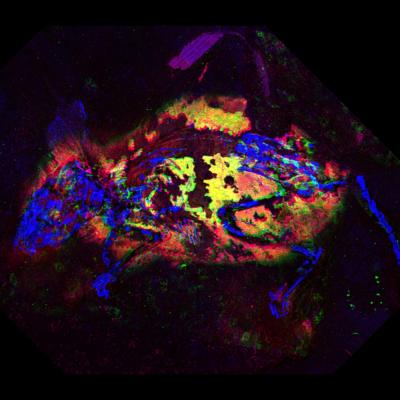
Researchers have for the first time detected chemical traces of red pigment in an ancient fossil—an exceptionally well-preserved mouse, not unlike today’s field mice, that roamed the fields of what is now the German village of Willershausen around 3 million years ago. The study revealed that the extinct creature, affectionately nicknamed “mighty mouse” by the authors, was dressed in brown to reddish fur on its back and sides and had a tiny white tummy. The results were published in Nature Communications.
The international collaboration, led by researchers at the University of Manchester, used X-ray spectroscopy and multiple imaging techniques to detect the chemical signature of pigments in this long-extinct mouse. X-ray analysis took place at SLAC’s Stanford Synchrotron Radiation Lightsource (SSRL) in the USA and the Diamond Light Source (DLS) in the UK.
“Life on Earth has littered the fossil record with a wealth of information that has only recently been accessible to science”, says Phil Manning, a professor at Manchester who co-led the study. “A suite of new imaging techniques can now be deployed, which permit us to peer deep into the chemical history of a fossil organism and the processes that preserved its tissues. Where once we saw simply minerals, now we gently unpick the ‘biochemical ghosts’ of long extinct species.”
Colour plays a vital role in the selective processes that have steered evolution for hundreds of millions of years. But until recently, techniques used to study fossils were not capable of exploring the pigmentation of ancient animals that is pivotal when reconstructing exactly what they looked like. This paper marks a breakthrough in the ability to resolve fossilised colour pigments in long-gone species by mapping key elements associated with the pigment melanin, the dominant pigment in animals. In the form of eumelanin, the pigment gives a black or dark brown colour, but in the form of pheomelanin, it produces a reddish or yellow colour.
Until recently, the researchers had focused on the traces of elements known to be associated with eumelanin, which in previous experiments revealed dark and light patterns in the feathers of the first birds, including Archaeopteryx, the famous fossil that first offered a clear link between dinosaurs and birds. In 2016, co-author Nick Edwards, scientist at SLAC, led a study that demonstrated the potential to differentiate between eumelanin and pheomelanin in modern bird feathers. That work provided a chemical benchmark for this most recent paper, which for the first time showed it is possible to detect the elusive red pigment, which is far less stable over geological time, in ancient fossils.
“We had to build up a strong foundation using modern animal tissue before we could apply the technique to these ancient animals”, Edwards said. “It was really a tipping point in using chemical signatures to crack the colouring of ancient animals with soft tissue fossils.”
“The fossils used in this study preserve amazing structural detail, but our work emphasises that such exceptional preservation may also lead to extraordinary chemical detail that changes our understanding of what is possible to resolve in fossils”, said Roy Wogelius, who co-led the study. “Along the way we learned so much more about the chemistry of pigmentation throughout the animal kingdom.”
The key to their work was determining that trace metals were incorporated into the fossilised mouse fur in exactly the same way that they bond to pigments in animals with high concentrations of red pigment in their tissue.

A false colour synchrotron X-ray image of the fossil chemistry. Blue represents calcium in the bones, green is the element zinc which has been shown to be important in the biochemistry of red pigment and red is a particular type of organic sulfur which cannot be imaged by traditional methods. This type of sulfur is enriched in red pigment. When combined, regions rich in both zinc and sulfur appear yellow on this image, showing that the fur on this animal was rich in the chemical compounds that are most probably derived from the original red pigments produced by the mouse. Credit: Nature Communications
“As you do research in a particular area, the scope of your techniques might evolve”, says Uwe Bergmann, co-author and a distinguished staff scientist at SLAC who led the development of the x-ray fluorescence imaging used in this research. “The hope is that you can develop a tool that will become part of the standard arsenal when something new is studied, and I believe the application to fossils is a good example.”










